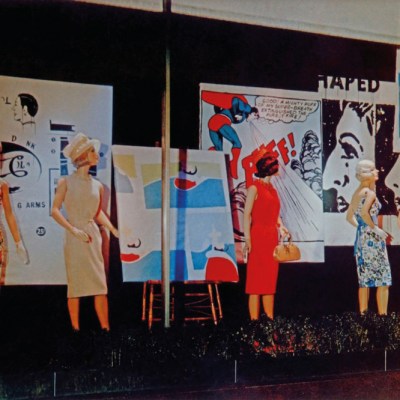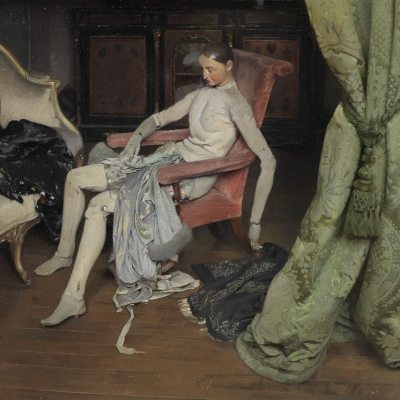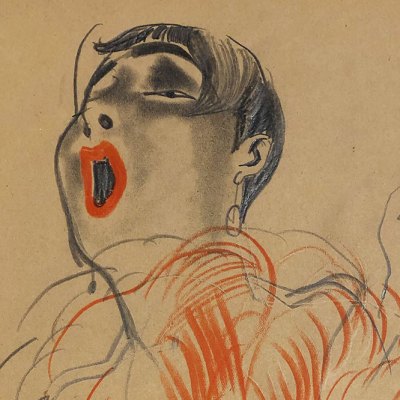Back in the 1980s, I worked briefly at Laurence Corner, an army surplus store on Drummond Street. One of my fondest memories from that time was dressing the mannequins in the shop windows. When, some years later, the opportunity arose to visit the factory that made them, I took the tour – and so began a fascination with these human effigies, once so artfully made, now so blank-faced and bland.
When Adel Rootstein set up her London factory to manufacture the fibreglass display-mannequins for shop windows in 1959, she was praised for closing the gap between the creativity of the fashion world and the conservatism of the retail environment. ‘Fashion was vibrant and exciting while the mannequins were formal and stiff: completely straight up and down and expressionless,’ Zandra Rhodes, designer and founder of the Fashion and Textile Museum, told The Guardian in 2008. Rootstein introduced liveliness and realism by modelling her mannequins on the actors, celebrities and models of the day and appealing directly to youth culture. Her prescience was well known: she spotted trends long before others did, choosing the right personalities to embody ‘the latest look’. Could she have foreseen that in the 21st century her creations would become collector’s items, more likely found in a museum than in a department store?
Installation view of ‘Outlaws: Fashion Renegades of 80s London’. Photo: Michael Cockerham; © Fashion and Textile Museum

In ‘Outlaws: Fashion Renegades of 80s London’ at the Fashion and Textile Museum, a spectacular cast of ‘mannequins-with-attitude’ is assembled to convey the loudness and wildness of nightclubs such as Taboo, where clubbers poured resourcefulness and artistry into handmade and subversive sartorial confections that lit up the gloom of the capital. Shirts with hand-drawn prints, dresses trimmed with rows of hair grips, a donkey jacket decorated with broken shells and pieces of vinyl, a cape made from a yellow shower curtain and trousers and tops stitched from souvenir tea towels or Turkish carpets – these were some of the saner garments on the scene. Then there were the individuals with stand-out style, among them David Cabaret, whose Bumps outfit (a black-and-white striped onesie of padded bumps that cover the whole body, including the hands) and canary-yellow spiked suit (the spikes are soft and can be squidged down) are included in the museum’s display.
Cabaret, who had hoped to work for Rootstein as a make-up artist, owns a substantial collection of Adel’s mannequins. He oversaw the art direction for ‘Outlaws’, supplying many of the figures for the show. ‘We were not trying to make it a waxwork display of people,’ he tells me. ‘But rather to capture a mood and style of certain characters on the scene.’
It’s striking how alive these mannequins look, with arms folded or hands on hips; a head leaning on someone’s shoulder; faces pouting; figures swaying, dancing, and deejaying. ‘Initially, we were just going to use them for the dancefloor area,’ Cabaret says. ‘The inspiration being the cover of Roxy Music’s Manifesto album, photographed in Rootstein’s showroom, but as we gathered more and more pieces, we realised they would be useful in other areas, such as the Michael Clark.’
Installation view of ‘Outlaws: Fashion Renegades of 80s London’. Photo: Michael Cockerham; © Fashion and Textile Museum

At its peak, Rootstein’s factory was producing 6,000 mannequins a year, bringing out a new collection every six months to coincide with the launch of the latest fashion season. Collections such as Go-Go, Heroes, Rave and The Locker Room brought a richer variety of human simulacra, some modelled on cultural icons that included Twiggy, Joan Collins, Donyale Luna (Cabaret’s favourite) and Dianne Brill; others on lesser-known individuals.
By the time I visited the factory in 1996, Adel Rootstein had died and the business had been sold to a Japanese company called Yoshichu. A tour took us through the process of making a mannequin, beginning with the clay model sculpted from life. I remember passing plastic moulds of torsos stacked on shelves, limbs leaning against walls, and the smell of fibreglass from the casts. Cellulose paints in eight different skin tones were sprayed on to arms and legs, which were hanging up to dry, and there were random boxes of ears (joined to the head separately). Upstairs, wigs were made with soft or stiff hair glued on to buckram caps with UHU. Up another flight of stairs, the ‘master’ painters applied the make-up to the heads using oils, after which soft eyelashes (for a more natural appearance) or stiff-haired lashes (for a sultry look) were added. A finisher then checked the heads, which was important, we were told, as clients were fussy: one German customer complained there were more hairs painted in a righthand eyebrow than in the left.
Installation view of ‘Outlaws: Fashion Renegades of 80s London’. Photo: Michael Cockerham; © Fashion and Textile Museum

The models for the mannequins, now much older, have described how they aimed to be ‘the best version of themselves’ for the Rootstein’s sculptor, what it felt like to see themselves in the shop window for the first time and how their youth is forever frozen in their mannequin. But even the mannequins have not escaped the ageing process. Once their moment was over, they were moved out of the window and on to the shop floor, at which point they were replaced by newer, fresher, unchipped versions. The fashion historian and curator Susan Bishop remembers working as a window dresser in the late 1960s. ‘We used Rootstein models, and I had to carry them through the crowds from one end of the store to the other – they were very heavy, and I remember shouting, “Mind your backs please!” on my journey.’
Today, theatrical window displays have all but vanished from the high street. Instead, we have corporate, doll-like dummies with no features. ‘Now, it’s all about displaying the product and not the lifestyle,’ Cabaret says. Perhaps we can project ourselves on to these mass-produced mannequins, whatever our age, gender, ethnicity, dress size or sexual persuasion, but I doubt it. After the pandemic, we are still going out less and shopping online more. In 2014, I happened to be passing Rootstein’s factory the day it closed, as it was sold – once again – this time to Bonaveri in Italy. I took pictures of some stylised figures painted in gold. They no longer possessed the Midas touch, but I hope they found a good home.
‘Outlaws: Fashion Renegades of 80s London’ is at the Fashion and Textile Museum, London until 9 March.


